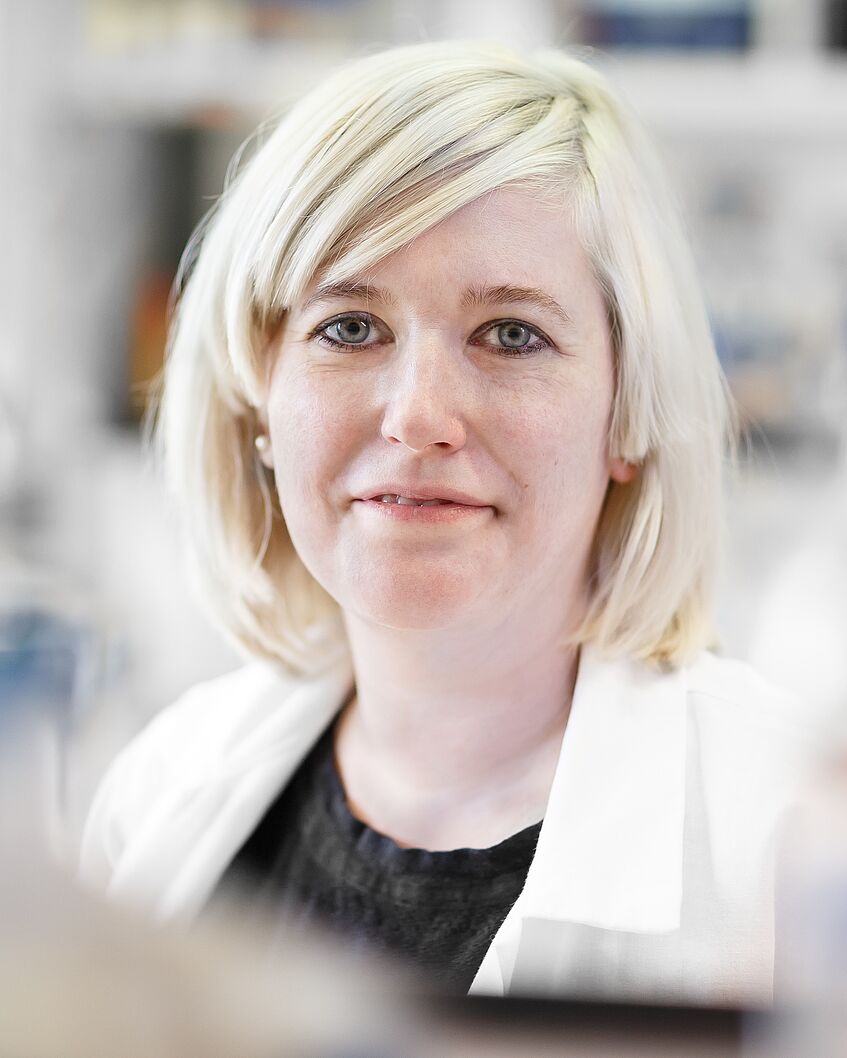Mag. Dr. Cornelia Rumpf-Kienzl

Mag. Dr. Cornelia Rumpf-Kienzl
E-Mail: cornelia.rumpf@univie.ac.at
Department of Microbiology, Immunobiology & Genetics
Project: “MMCA” - Molecular Mechanisms of Centrosome Assembly
Centrosomes are cytoplasmic organelles in animal cells whose primary function is to organize the microtubule cytoskeleton. As such, they contribute to organelle positioning, cellular trafficking, and cell division. Consistent with their central role in cellular architecture, defects in centrosome number and structure have been linked to a variety of human disorders, including cancer, microcephaly and dwarfism. Centrosome abnormalities are particularly prevalent in solid tumors as well as hematological malignancies, where they are associated with poor prognosis. Centrosomes are formed by the recruitment of microtubule-organizing pericentriolar material (PCM) to a pair of centrioles whose duplication once per cell cycle ensures the formation of a bipolar spindle during cell division. While the molecular pathways underlying centriole duplication have become much clearer in recent years, the nature of the pericentriolar material and how it is recruited to centrioles remains largely unknown.
Classical experiments have revealed the existence of a filamentous matrix within the pericentriolar material that serves as a scaffold for the recruitment of other proteins that nucleate and anchor microtubules. The molecular composition of this scaffold, thought to be central to centrosome assembly, has not been determined. In this project I will combine biochemical and cell biological approaches to characterize the pericentriolar matrix at a molecular level. The proposed work is divided into two complementary aims. First, I will isolate and extract centrosomes from Drosophila and C. elegans embryos and use mass spectrometry to determine the molecular composition of the salt-insoluble pericentriolar matrix. Second I will use proximity-dependent labeling to study protein-protein interactions across the centriole-pericentriolar material interface. Candidate proteins and protein interactions will be further investigated by high-resolution microscopy in live embryos.
The approaches briefly outlined above aim to capitalize on the advantages of Drosophila melanogaster and C. elegans as experimental models to investigate the fundamental and conserved molecular mechanisms underlying centrosome assembly. Successful completion of this work should further our understanding of these cellular structures, which are of key relevance to human development and disease.
Publications
Publications
- Clijsters L, van Zon W, Riet BT, Voets E, Boekhout M, Ogink J, Rumpf-Kienzl C, Wolthuis RM. 2014. Inefficient degradation of cyclin B1 re-activates the spindle checkpoint right after sister chromatid disjunction. Cell Cycle (13):2370-8.
- Kovacikova I, Polakova S, Benko Z, Cipak L, Zhang L, Rumpf C, Miadokova E, Gregan J. 2013. A knockout screen for protein kinases required for the proper meiotic segregation of chromosomes in the fission yeast Schizosaccharomyces pombe. Cell Cycle (12):618-24.
- Cipak L, Zhang C, Kovacikova I, Rumpf C, Miadokova E, Shokat KM, Gregan J. 2011. Generation of a set of conditional analog-sensitive alleles of essential protein kinases in the fission yeast Schizosaccharomyces pombe. Cell Cycle(10):3527-32.
- Rumpf C, Cipak L, Schleiffer A, Pidoux A, Mechtler K, Tolić-Nørrelykke I, Gregan J. Laser microsurgery provides evidence for merotelic kinetochore attachments in fission yeast cells lacking Pcs1 or Clr4. Cell Cycle, 2010 Oct3; 9(19)
- Rumpf C, Cipak L, Dudas A, Benko Z, Pozgajova M, Riedel CG, Ammerer G, Mechtler K, Gregan J. 2010. Casein kinase 1 is required for efficient removal of Rec8 during meiosis I. Cell Cycle (9):2657-62.
- Rumpf C, Cipak L, Novatchkova M, Li Z, Polakova S, Dudas A, Kovacikova I, Miadokova E, Ammerer G, Gregan J. 2010. High-throughput knockout screen in Schizosaccharomyces pombe identifies a novel gene required for efficient homolog disjunction during meiosis I. Cell Cycle (9):1802-8.
- Spirek M, Benko Z, Carnecka M, Rumpf C, Cipak L, Batova M, Marova I, Nam M, Kim DU, Park HO, Hayles J, Hoe KL, Nurse P, Gregan J. 2010. S. pombe genome deletion project: An update. Cell Cycle (9):2399-402.
- Spirek M, Novatchkova M, Cipak L, Chen Z, Rumpf C, Mechtler K, Ammerer G, Gregan J. 2009. A novel strategy for TAP-tagging of S. pombe genes. Proteomics (9):4825-8.
- Gregan J, Rumpf C, Li Z, Cipak L. 2008. What makes centromeric cohesion resistant to separase cleavage during meiosis I but not during meiosis II? Cell Cycle (7):151-3.
- Gregan J, Spirek M, Rumpf C. 2008. Solving the shugoshin puzzle. Trends Genet. (24):205-7.
- Gregan J, Riedel CG, Pidoux AL, Katou Y, Rumpf C, Schleiffer A, Kearsey SE, Shirahige K, Allshire RC, Nasmyth K. 2007. The kinetochore proteins Pcs1 and Mde4 and heterochromatin are required to prevent merotelic orientation. Current Biology (17):1190-1200.
- Kern A, Hartner FS, Freigassner M, Spielhofer J, Rumpf C, Leitner L, Fröhlich KU, Glieder A. 2007. Pichia pastoris "just in time" alternative respiration. Microbiology (153):1250-60.
- Gregan J, Zhang C, Rumpf C, Cipak L, Li Z, Uluocak P, Nasmyth K, Shokat KM. 2007. Construction of conditional analog-sensitive kinase alleles in the fission yeast Schizosaccharomyces pombe. Nature Protocols (2): 2996-3000.
- Gregan J, Riedel CG, Petronczki M, Cipak L, Rumpf C, Poser I, Buchholz F, Mechtler K, Nasmyth K. 2007. Tandem affinity purification of functional TAP-tagged proteins from human cells. Nature Protocols (2):1145-51.
- Gregan J, Rabitsch PK, Rumpf C, Novatchkova M, Schleiffer A, Nasmyth K. 2006. High-throughput knockout screen in fission yeast. Nature Protocols (1): 2457-64.
- Gregan, J, Rumpf C. 2006. How might DNA enter the cohesin ring? Cell Cycle (5): 2553-4.
